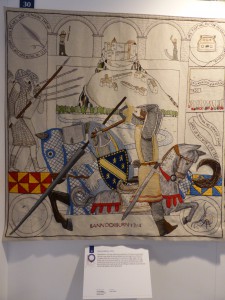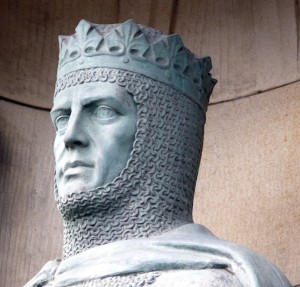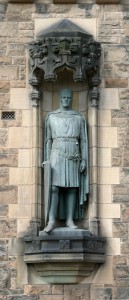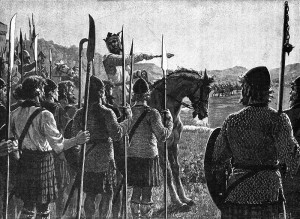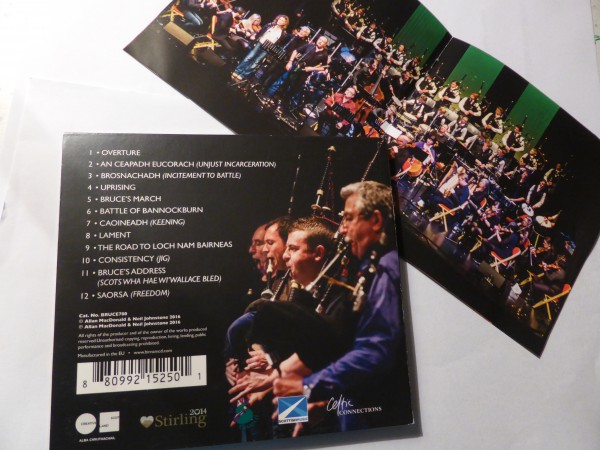Am Brusach 700
Anns an Ògmhios gach bliadhna thèid Blàr Allt a’ Bhonnaich a chomharrachadh, blàr le buil na bu bhuannachdaile do dh’Alba na Blàr Chùl Lodair a thachair 450 bliadhna as a dhèidh. Tha a‘ bhliadhna 1314 loisgte san DNA gach Albannaich, mar shamhla de shaorsa as dèidh nam bliadhnaichean fada de dh’ainneart fo na rìghrean Shasainn. Nach iomadh tilleadh, pearsanta agus poiliteagach, chaidh aig Raibeart Brus air an obair a thòisich Uilleam Uallas a chrìochnachadh. Fhuair e buaidh an aghaidh airm Shassanaich a bha mòran na bu mhotha, le cath-innleachd ghlic, m.e. roghainn làraich, slochdan falaichte, schiltrons, le comas ceannardais, agus le saighdearan Albannach dìleas, a’ sabaid airson an saorsa.
‘S e ceann-bliadhna sònraichte a bha ann an 2014 agus chaidh a’ bhuaidh a chomharrachadh ann an dòighean eadar-dhealaichte air feadh na h-Alba. Bha aon tachartas ann far an lùiginn a bhith ann, cuirm-ciùil air leth ann an Sruighlea, faisg air Allt a’ Bhonnaich, Am Brusach 700. ‘S ann aig Ailean Dòmhnullach, sàr-phìobaire às an teaghlach-pìobaire ainmeil à Gleann Uige, a bha am bun-smaoineas. Bha e airson na seann tradiseanan pìoba, ciùil is bàrdachd a chleachdadh gus dealbh bheothail den bhlàr agus de na làithean roimhe agus as a dhèidh a chruathachadh. Gus na pàirtean eadar-dhealaichte (caismeachdean, brosnachadh, caoineadh amsaa) a cheangal agus crùth aonaichte is urramaichte a thoirt dhaibh, cho-obraich e còmhla ri Niall MacIain, sgrìobhaiche-ciùil Albannach aithnichte, a chleachd orcastra bheag ri taobh sheinneadairean agus luchd-ciùil tradiseanta le pìoban, fìdhlean, fideagan, clàrsaich, agus drumaichean. Agus thàinig obair air leth às, cuirm-chiùil chruinnte, tharraingeach.
Cha deach a chluich ach dà thuras, ann an Sruighlea san Ògmhios 2014 agus aig Celtic Connections ann an Glaschu ann an 2015 – iomairt uabhasach doirbh, leis na h-uiread de luchd-ciùil a bha air an ùrlar (nam measg còmhlan-pìoba òigridh à Sruighlea) agus na duilgheadasan a bh’ ann na sàr-sheinneadairean mar Ghriogair Labhraidh, Caitlin NicAonghais, Rod Paterson agus Ailean fhèin a thoirt còmhla. Chaidh a’ chuirm aig Celtic Connections a chlàradh, agus anns a’ Ghiblean am bliadhna nochd an CD, mu dheireadh thall. Ach rud a thug fìor thoileachas dhomh, air nach robh dùil agam idir, ‘s ann gun deach cuirm eile a chur air dòigh sa Ghearmailt, agus b’ urrainn dhomh a bhith ann!
‘S ann ann an Hofheim am Taunus, faisg air Frankfurt, a bha an tachartas, am baile far a bheil an aon Sgoil-Phìoba Albannach anns an Roinn Eòrpa mhòr-thìreach. ‘S e Thomas Zöller, ceannard den sgoil agus co-obraiche fad-ùineach Ailein Dòmhullaich, a chuir a’ chuirm-chiùil air dòigh – pròiseact doirbh agus daor. Ach b’ fhiach e an t-saothair! Oidhche mhòr leis na h-aon sàr-sheinneadairean agus luchd-ciùil Albannach, fiù ‘s cuid den chòmlan-pìoba òigridh à Srùighlea, ach le orcastra ionadail à Hofheim, Thomas fhèin air a‘ phìob còmhla ri Ailean, agus sgoilearan-pìoba aigesan a‘ cluich cuideachd. Iomairt le fìor spioraid càirdeis, agus an talla loma-làn.
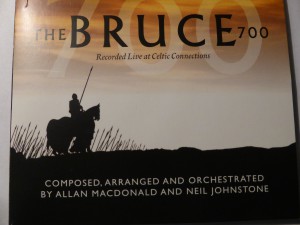 Bha a h-uile rud tarraingeach, a’ gluasad eadar innealan-ciùil agus guth, pìoban agus orcastra, pìosan luath agus slaodach, brònach agus aoibhneach. Gabh Caitlin NicAonghais an Caoineadh, agus Rod Paterson Scots Wha Hae, agus bha na pìoban uile gu lèir drùidhteach. Tha e doirbh na pàirtean as fheàrr leam ainmeachadh, ach tha dà phìos ann a tha nam cheann fhathast. An toiseach am Brosnachadh, air a sheinn le Griogair Labhraidh – bàrdachd tradiseanta chumhachdach a’ brosnachadh nan saighdearan – “A chlanna Gàidheil na h-Albann air allaban ‘nis falbh leam gu buaidh no gu bàs gu bàs”. Agus an t-òran mu dheireadh, Saorsa, air a ghabhail le Ailean Dòmhnullach agus an sgioba-cluiche gu lèir – na bhrosnachadh agus na shubhachas aig an aon àm, laoidh shimplidh is làidir a thogas am meanmna. “O thèid mi fhìn le mo dheòin, Thèid agus gun tèid mi le mo dheòin. O thigibh le chèile le bhur deòin, Nì sinn ar dìcheall gu ceann.“
Bha a h-uile rud tarraingeach, a’ gluasad eadar innealan-ciùil agus guth, pìoban agus orcastra, pìosan luath agus slaodach, brònach agus aoibhneach. Gabh Caitlin NicAonghais an Caoineadh, agus Rod Paterson Scots Wha Hae, agus bha na pìoban uile gu lèir drùidhteach. Tha e doirbh na pàirtean as fheàrr leam ainmeachadh, ach tha dà phìos ann a tha nam cheann fhathast. An toiseach am Brosnachadh, air a sheinn le Griogair Labhraidh – bàrdachd tradiseanta chumhachdach a’ brosnachadh nan saighdearan – “A chlanna Gàidheil na h-Albann air allaban ‘nis falbh leam gu buaidh no gu bàs gu bàs”. Agus an t-òran mu dheireadh, Saorsa, air a ghabhail le Ailean Dòmhnullach agus an sgioba-cluiche gu lèir – na bhrosnachadh agus na shubhachas aig an aon àm, laoidh shimplidh is làidir a thogas am meanmna. “O thèid mi fhìn le mo dheòin, Thèid agus gun tèid mi le mo dheòin. O thigibh le chèile le bhur deòin, Nì sinn ar dìcheall gu ceann.“
Faodaidh mi an CD a mholadh gu mòr ma bhios uibh agaibh ann an ciùil Albannach, no ann am Brus, no anns a’ Bhlàr.
http://www.musicinscotland.com/acatalog/The-Bruce-700.html
Tha pàirtean den chuirmean-ciùil rim faighinn air YouTube (lorg The Bruce 700) agus Facebook – ceanglaichean aig an deireadh.
Fiosrachadh sa Bheurla an seo: http://www.pipefest.com/event-news/the-bruce-700-composed-by-allan-macdonald/
*************************************************************************
The Bruce 700
In June each year the battle of Bannockburn is celebrated, a battle with a more favourable outcome for Scotland than Culloden 450 years later. The year 1314 is etched into the DNA of every Scot, as a symbol of freedom after the long years of oppression under the English kings. After many setbacks, personal and political, Robert the Bruce managed to finish the work William Wallace has started. He was victorious against a much more numerous English army through clever military strategy, such as choice of battleground, hidden pits and the use of schiltrons, though his leadership skills, and with the loyal Scottish soldiers fighting for their freedom.
2014 was a special anniversary and it was marked by various events throughout Scotland. There was one event I would have loved to be at, a brilliant concert in Stirling, near Bannockburn, called The Bruce 700. This was the brainchild of Allan Macdonald, master-piper from the famous piping family of Glenuig. He wanted to use the classical traditions of piping, music and poetry to create a vivid picture of the battle and the days before and after. To bind the different elements together (marches, calls to arms, laments etc) and to give the whole a unified, dignified frame, he collaborated with the renowned Scottish composer Neil Johnstone, who used a small orchestra alongside traditional singers and musicians on pipes, fiddles, whistles, harps and drums. And it turned into an outstanding piece of work, a rounded and gripping concert experience.
It was only performed twice, in Stirling in June 2014, and at Celtic Connections in Glasgow in 2015 – a challenging project, with so many people on stage (including a youth pipe band from Stirling) and the difficulties of coordinating the schedules of some of the best Scottish singers – Griogair Labhraidh, Kathleen MacInnes, Rod Paterson and Allan Macdonald himself. The Celtic Connections performance was recorded, and in April this year the CD came out, at long last. But the thing that really delighted me, that I hadn’t expected, is that it was to be performed live once again, in Germany, and that I could be there!
The event was in Hofheim am Taunus, near Frankfurt, home of the only Scottish Piping School in mainland Europe. It’s Thomas Zöller, head of the school and long-term collaborator of Allan Macdonald’s, who organised it – a tricky and expensive enterprise. But it was worth it. It was a great night, with the same stellar Scottish soloists and musicians, even some of the youg pipe band form Stirling, but with a local orchestra from Hofheim, Thomas himself on pipes alongside Allan, and some of his own students playing too. There was a real spirit of friendship on stage, and the hall was packed to bursting.
The whole thing was fascinating, moving between instrumentals and voice, fast and slow pieces, sad and joyful ones. Kathleen MacInnes sang the Caoineadh (Keening) and Lament, and Rod Paterson a moving Scots Wha Hae, and the pipes were impressive altogether. It’s hard to name favourites parts, but two pieces have stayed in my head ever since. First the Brosnachadh (Incitement to Battle), sung by Griogair Labhraidh – a powerful traditional poetic song to encourage the soldiers – “wandering children of the Gael, go with me now to victory or death!” And the last song, Saorsa (Freedom), sung by Allan Macdonald and the whole cast – inspiration and celebration at the same time, a simple but powerful anthem that lifts the spirits. “Oh I will go, by my will…come together with your will, we will reach our goal by our own efforts.”
I can heartily recommend the CD if you are at all interested in Scottish music, the Bruce, or in the battle itself.
http://www.musicinscotland.com/acatalog/The-Bruce-700.html
You can hear parts of the concerts on YouTube (look for The Bruce 700) or Facebook – here are some links:
https://www.facebook.com/neil.johnstone.9/videos/1095905050468126/
https://www.facebook.com/neil.johnstone.9/videos/1065508630174435/
https://www.facebook.com/neil.johnstone.9/videos/1068480819877216/
And more details about the work here: http://www.pipefest.com/event-news/the-bruce-700-composed-by-allan-macdonald/
*copyright Ad Meskens, Wikimedia Commons, with thanks. Mòran taing!
** Public domain works of art (via Wikipedia)
5.09.2016:
Artaigil san National / article in The National:
http://www.thenational.scot/culture/the-bruce-700-has-brought-listeners-to-tears-now-its-going-global.21976
“The Bruce 700 has brought listeners to tears … now it’s going global”
